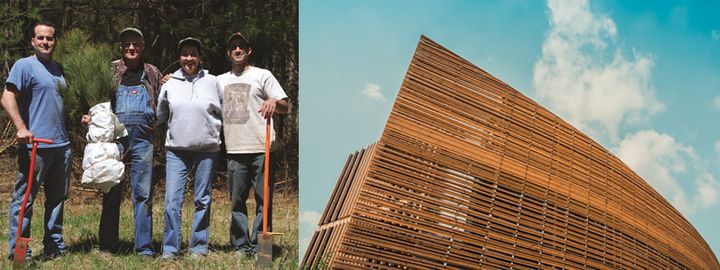
By Tom Martin and Robert Glowinski
We all know from our elementary science classes that trees absorb carbon dioxide (CO₂) during their growth cycle. Once absorbed, trees lock that carbon in, keeping it out of the atmosphere. In fact, forests, and forest products, capture and store 13 percent of the U.S.’s greenhouse gas emissions each year.
But what many do not know, is that the majority of these forests are owned by family forest owners, not the government or corporations. These family forest owners want to do the right thing to keep their forests healthy, providing for wildlife, keeping water clean, and storing carbon, but they face significant risks and costs, including forest fires, insect infestations, and the ongoing and ever-increasing cost of forest management.
Having robust markets for their timber and wood products is critically important to helping landowners overcome these barriers, as it gives them the needed income to manage risks, replant, restore and keep forests as forests. Without income to cover these costs and offset the risks being taken, continued family ownership of woodlands would be in danger of being sold and converted to soybean fields or strip malls. These markets are important to helping keep our carbon sink.
On the other hand, the construction of buildings, and the manufacturing of the products used to construct them, account for 39 percent of all CO₂ emissions per year in the United States alone – more than any other country in the world except China. So, the emergence of the green building trend to use wood, presents a real opportunity to reduce CO₂ emissions in the building process, store more carbon in the buildings themselves, and help forest owners keep their forests as forests and our great carbon sink intact.
It is vital that we continue to explore and grow the green building trend.
Innovative technologies for building with “mass timber” are allowing construction of buildings 10 stories and higher. Just last month, an 18-story mass timber building was completed at the University of British Columbia.
The reason these products are gaining attention? Environmental benefits. Using wood building products in place of fossil fuel-intensive materials not only reduces the greenhouse gases that would have been emitted during manufacture of such products, but provides the additional benefit that the timber products continue to store the CO₂ absorbed by trees. And there is even more carbon stored in the larger mass timber panels used for constructing tall buildings.
Interestingly, tall wood buildings have existed for centuries. In Japan, tall wood pagodas were built in the 7th century up to 19 stories and some still stand today in high seismic and wet climate environments. Several countries around the world have a more recent history of constructing tall wood buildings of up to nine stories. In 2008, the Stadthaus project in London was the impetus for continued innovation in mass timber building - evident in current proposals for bigger and taller buildings in wood up to 30 stories. Larger, heavy timber structures have stood in North America for the last 100 years.
It’s important to note that mass timber buildings are significantly different from lightweight construction. Each has an appropriate role in constructing the many buildings built each year in North America, but one thing both types of buildings have in common is their ability to lock away carbon for long periods of time, keeping it out of the atmosphere as CO₂.
Our forests provide us with immense benefits, from clean water and wildlife habitat, to clean air and a carbon sink. But we must invest in our forests and in the individuals, such as family forest owners, who care for them in order to continue reducing our country’s carbon emissions even further. Substituting wood construction and incorporating mass timber into our building practices not only has the potential to revolutionize the building industry, it will also encourage the vibrant markets needed to maintain our privately-owned forests.
Robert Glowinski is the President & CEO of the American Wood Council. Tom Martin is the President & CEO of the American Forest Foundation.
